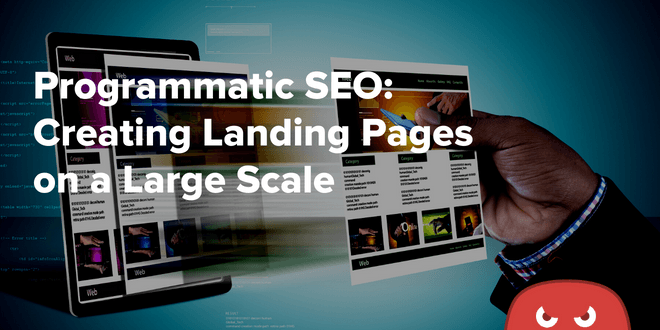Quick Links
If you search for ‘top things to do in New York City,’ you’re bound to see the popular travel site Tripadvisor in the top results, if not as the top organic search result.
The amazing part?
Tripadvisor will also rank high for ‘top things to do in New Jersey,’ ‘top things to do in Atlanta,’ and countless others. No matter the city, Tripadvisor always has a landing page ready with unique things to do.
As you can imagine, that type of SEO dominance requires creating thousands (or even millions) of landing pages for travel-related search queries.
But how is this possible? Do they have a content creation team on call 24/7 to create all the articles?
Believe it or not, it’s not because of magic, nor is it due to Tripadvisor‘s considerable sphere of influence/budget.
Instead, it’s because Tripadvisor (and other websites like Yelp and Zapier) use what’s known as programmatic SEO.
It’s a specialized SEO strategy that uses specialized code to create thousands of landing pages for thousands of keywords.
Programmatic SEO is a way to release a ton of similar content en masse, such as things to do in certain cities or restaurant reviews. E-commerce websites also make heavy use of the technique.
When done right, programmatic SEO can help generate a ton of search traffic, leads, and conversions.
Read on to learn more about programmatic SEO, including its benefits and how you can implement it into your SEO strategy.
What Is Programmatic SEO?
A website like Yelp has unique needs when it comes to search engine optimization. In essence, Yelp is a gigantic directory of local business information and reviews.
Their model requires thousands of landing pages, each tailored to a unique local business. Not only that, but to find success, they need to appear at the top of online search results for hyper-specific keywords.
You can see this in action with a website like Yelp, as they often rank first on Google for keywords like ‘best restaurant in (city name)’ or ‘best activity in (city name).’
Programmatic SEO is how they’re able to achieve such an impressive feat. A programmatic SEO strategy involves creating thousands of similar yet different landing pages that cater to user search intent.
It uses a combination of automation and coding savviness to mass-produce landing pages tailored to different keywords.
In a nutshell, they gather thousands (often 100,000+) of keywords to use for their generated pages.
They often have a design template for each type of landing page, meaning only the content itself changes from page to page.
For example, the Tripadvisor page for The 10 Best Restaurants in Charlotte has the same design and layout as The 10 BEST Restaurants in Atlanta. In fact, all their ‘BEST restaurants in‘ articles copy this same layout. The only thing that changes from page to page is the actual content – which is what programmatic SEO is all about.
After all, spending the time and resources to handcraft each landing page wouldn’t be feasible, even for websites as large and well-known as Tripadvisor and Yelp.
Why is Programmatic SEO Important/Valuable?
![]() The good news is that programmatic SEO isn’t exclusively for enterprise-level companies. Anyone can incorporate the technique with a little know-how and some coding prowess.
The good news is that programmatic SEO isn’t exclusively for enterprise-level companies. Anyone can incorporate the technique with a little know-how and some coding prowess.
Programmatic SEO is an extremely valuable technique for a variety of reasons, including that it’s a great way to circumvent the traditionally lengthy SEO process.
By mass-releasing landing pages, you can start to see boosts in traffic and revenue far sooner.
While there’s plenty of hype surrounding releasing the highest quality content possible, SEO gurus often fail to mention the other side of the coin– quantity.
To them, quality trumps all, and you shouldn’t focus on releasing large quantities of content.
But is that always the case?
It turns out that it’s not.
While it’s true that you shouldn’t release a ton of low-quality articles, publishing a large quantity of high-quality content is a good thing– and programmatic SEO lets you achieve that.
By using programmatic SEO techniques, you’ll be able to create a page for every product, service, and category on your website – all without manually building each page.
Since each webpage will be optimized for highly specific search terms (often long-tail keywords), they’ll likely perform very well in the search rankings.
As a result, all these optimized landing pages will generate a ton of organic traffic for your business.
Who Benefits from Programmatic SEO Strategies?
Programmatic SEO is also a necessity for many types of websites, such as:
- Ecommerce
- Review sites
- Travel sites
- Q&A forums (Reddit and Quora)
The nature of these websites requires them to have thousands of specialized landing pages, which is why programmatic SEO is crucial to their business models.
While each landing page has a similar design and layout, the content on each is relevant, unique, and provides a pleasant user experience. You can attest to this if you’ve ever found a helpful review on Yelp or Tripadvisor.
Beyond that, any business that has an online presence can use and benefit from programmatic SEO. We’ve already mentioned how you can use it to create webpages with minimal effort, which will help you save valuable resources.
Programmatic SEO will help you get more of your content ranking in Google search results with minimal effort, which is excellent for small businesses and startups.
Whether you’re an enterprise-level company or an entrepreneur with an e-commerce site, programmatic techniques have the power to drive massive amounts of traffic to your website without the need for extra busy work from your staff.
As a rule of thumb, the more landing pages your website needs, the more helpful programmatic SEO will be for you.
Besides generating massive amounts of traffic, you’ll also enjoy numerous other benefits from implementing programmatic optimization techniques, so let’s look at more.
Bolsters online presence
Digital marketing is the way of the future, as there are a whopping 2.14 billion online shoppers – and this number only continues to go up. In fact, the total number of online shoppers continues to increase with every passing year.
That means if any company wants to survive going forward, they need to have a strong online presence. It also means that your potential audience is continuing to grow, which is a good thing.
Programmatic SEO is one of the most reliable ways to strengthen your online visibility.
Fact: Google views websites that don’t have much content as less authoritative than ones that have an extensive library of articles.
The proof?
Google’s John Mueller has said, “it’s hard to view a website as authoritative if it only has 30 pieces of content.”
That means Google ranks websites with more pages of content (as long as they’re relevant and high-quality) higher than those with only a few pages (even if their quality is outstanding).
So if a new company wants to gain visibility on search engines, they’ll need to produce not only quality content but also quite a bit of it. That’s a tall task for a startup that lacks a large content creation team – but programmatic SEO techniques can make producing a ton of unique content feasible.
With clever keyword research and top-tier copywriting, any sized company can use programmatic SEO to increase its visibility on search engines.
Internal link building
A robust internal linking structure is an essential part of any link-building strategy. In short, every page on your website should have another page pointing to it through a link.
Why is that important?
The reason is two-fold.
First, a logical internal linking structure is essential for Google’s algorithms and crawlers to properly discover, crawl, and index all the pages on your website. If a page on our website has no links pointing to it, it’s known as an orphan page, and it can wreak havoc on your crawl budget.
Google will only crawl a given number of pages on your website a day (this number varies heavily). If you have orphan pages hanging around, it causes Google’s crawl rate to slow down because it can’t find the natural connections between pages on your site (internal links).
That can even cause Google to delay crawling more essential pages on your site while it tries to figure out your orphan pages.
You also need internal links because they help keep users engaged with your website. Instead of clicking off to another page, they may begin reading another blog post – which increases dwell time and reduces bounce rates.
Programmatic SEO > Link spam
Programmatic SEO will allow you to create many high-quality landing pages relevant to your target audience – and you can easily include internal links in them all.
That’s a far better strategy than creating a ton of low-quality pages that only exist for internal links and backlinks – which won’t get you very far. Users won’t engage with useless content, and they’ll become frustrated at its inclusion.
Not only that, Google does NOT like link spam, so always ensure the content you release is helpful for your audience.
Frees up employee time
Is your staff tied up all day manually updating your existing web pages to improve SEO – such as performing technical tweaks, adding keywords, and targeting SERP features like snippets?
If so, that’s a clear sign you need to find a way to produce new pages that are already optimized for SEO.
That way, your staff won’t have to go back and optimize them after the fact.
Programmatic SEO will allow you to create thousands of landing pages that are perfectly optimized for the right keywords straight from the get-go.
Your content creation team won’t have to manually create each new webpage, either, which is another huge timesaver.
Programmatic SEO works in tandem with other essential tools, such as automation centers and affiliate tracking programs – so once you get everything set up, it practically runs on autopilot.
As a result, you’ll be able to free up tons of employee hours that you can use to focus on more pressing tasks, such as brainstorming new ways to scale your business.
How To Do Programmatic SEO
Since you know what programmatic SEO is and how it can benefit you, it’s time to roll up your sleeves and learn how to do it yourself.
It starts with keyword research, as most SEO strategies do, albeit on a bit more of a mass scale. Without further ado, here’s a step-by-step guide to implementing a programmatic SEO strategy.
Find your essential head terms
You don’t just need 10 or 20 keywords for programmatic SEO – you need at least 2,000. In fact, it’s common for some websites to target 100,000+ keywords for their strategy.
How do they find so many keywords to target?
They certainly don’t do it one by one. Instead, they target head terms – which are broad-level categories that encompass a ton of keywords.
Examples of head terms include:
- Travel sites: Things to do, hotels
- Review sites: Restaurants, barbershops, gyms, etc.
- Retail sites: Electronics, groceries
Head terms should have a ton of search volume, especially when you pair them with modifiers (i.e., the best restaurant in blank).
Whenever you’re coming up with head terms, you should double-check their search volume to confirm they’re worth targeting.
Google Trends and our keyword planner tool from The HOTH are excellent tools you can use for this. If a keyword has a high search volume, check to ensure it’s not dropping off in popularity in Google Trends.
The last thing you want is to invest time and resources into a head term only to discover that it’s waning in popularity (with no chance of relevancy returning anytime soon).
If its popularity is trending up, that’s a clear sign it’s a head term worth pursuing.
How many head terms do you need?
It depends on how many different services you provide through your website. A business review site like Yelp needs lots of head terms, while a travel site such as Tripadvisor doesn’t quite need as many.
Find modifiers for your head terms
Now it’s time to start adding modifiers to your head terms. While your head terms will have significant search volume, the real deal comes from combining them with modifiers that also have high search volume.
You can use the same tools as you did before to learn the search volume for your modifiers (Google Trends and our keyword planner tool).
There are primary modifiers and secondary modifiers for head terms, so let’s learn the difference.
A primary modifier creates a new subcategory, while secondary modifiers further describe the head term.
Here are some examples of primary modifiers:
- Coats: Winter coats, coats with lots of pockets, coats with hoods
- Bars: Bars with live music, sports bars, bars with poker tournaments
- Electronics: Prosumer electronics, video games, movies
As you can see, each modifier creates a subcategory for the head term. Winter coats, for example, would contain all the winter coats you have for sale in your store.
Here are some examples of secondary modifiers:
- Coats: high-quality coats, affordable coats, expensive coats
- Bars: Top-tier bars, high-end bars, non-alcoholic bars
- Electronics: Affordable electronics, unique electronics, computer electronics
If your business is after local customers, your modifiers should follow the formula of head term + location (i.e., Electronics in Arizona).
Combine your keywords and modifiers
Lastly, you need to compile your head terms, primary modifiers, and secondary modifiers into a giant list.
This is where having some coding knowledge pays off. In particular, Python is a preferred language for coding and organizing programmatic SEO keywords. However, any coding software will get the job done.
It’s also wise to save a copy of your list in Google Sheets to have a backup.
How many keywords do you need?
It will depend on the scope of your SEO project. If you’re a gigantic travel site like Tripadvisor, you’ll need something like 100,000 keywords. If you’re a smaller business, 2,000 keywords will suffice.
Creating landing pages on a large scale
Now comes the tricky part, creating all your landing pages. Bear in mind that you won’t have to make a landing page for every one of your 100,000 keywords. You’ll still need to figure out a way to build tons of pages, but you won’t quite need 100,000 if you base your landing pages on user search intent.
For instance, the search intent behind several of your keywords may be exactly the same, requiring the creation of only one landing page for them all.
As with the Tripadvisor and Yelp pages, programmatic SEO landing pages often contain an identical layout. The pictures, design, and information can remain the same on all of them as long as the primary content changes. (i.e., all the 10 BEST restaurant articles have the same design besides the actual restaurant choices).
Automation can really save the day here if you’re able to replicate one page en masse with a few distinct changes.
Some programmatic sites take advantage of the two-sided marketplace method.
What’s that?
It’s where you design the basic layout of the website, and your vendors/users fill out the rest. An example would be a website like eBay, where users provide product descriptions and images for each item.
Concluding Thoughts: Programmatic SEO
By now, you should understand how programmatic SEO works, as well as how you can implement it in your organization.
Travel and review sites primarily use the technique, but any business can use programmatic SEO.
It’s a great way to supercharge your content marketing strategy by getting large quantities of high-quality content out there. It can also expedite the traditionally slow SEO process, which is a huge plus.
Do you not have the time, resources, or expertise to conduct an SEO strategy at your company?
Then you need to try our five-star managed SEO services at HOTH X.








